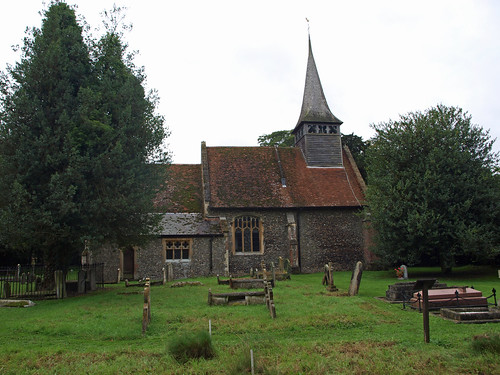St Mary and St Christopher was locked with no keyholder listed. It's a really charming little church and the graveyard, or rather large parts of it, has been set aside as a nature reserve - an idea also followed at Little Sampford. This adds huge interest to a large graveyard particularly when the different areas have such informative signage as they do here. I do hope the local primary school, assuming there is one, makes full use of it as a learning tool.
I rather suspect the interior would be a disappointment so I wasn't too disappointed to find access denied.
ST MARY. Nave, chancel, and belfry. All C15. The belfry on timber posts, the S porch also of timber with pretty side openings. Tomb Recess in the nave N wall with depressed pointed arch. - PULPIT with re-used early C16 tracery panels similar to several used in furniture at Panfield Hall. - STAINED GLASS. Two whole C15 figures of saints (N window, nave). - PLATE. Late C16 Paten; late C17 Cup.
ST MARY. Nave, chancel, and belfry. All C15. The belfry on timber posts, the S porch also of timber with pretty side openings. Tomb Recess in the nave N wall with depressed pointed arch. - PULPIT with re-used early C16 tracery panels similar to several used in furniture at Panfield Hall. - STAINED GLASS. Two whole C15 figures of saints (N window, nave). - PLATE. Late C16 Paten; late C17 Cup.
PANFIELD. Though it has nothing Norman to show, it has a link with the Conqueror, Great Priory Farm being the 17th century successor of a priory belonging to St Stephen’s at Caen, the abbey where William was buried. The church is nearly all 15th century, with a wooden turret, a charming porch, and the original door still on its hinges. Another doorway is 14th century, and has heads of a bearded man and a plump-faced queen. In a little fine old glass are two golden-haired saints, one with an orb and one with a yellow cross; and in a circle the eagle of St John is pecking at its wing. The modern pulpit has tracery 500 years old. Nearly as old as the church is Panfield Hall half a mile away, remarkable for its projecting tower and a group of Tudor chimneys.
Flickr set.


No comments:
Post a Comment